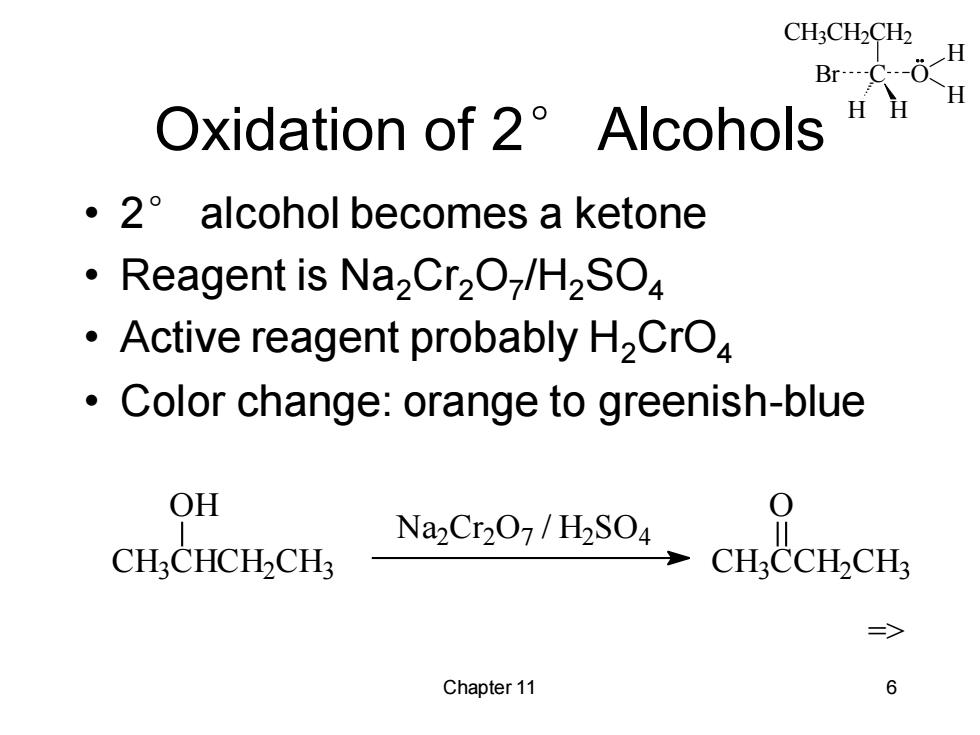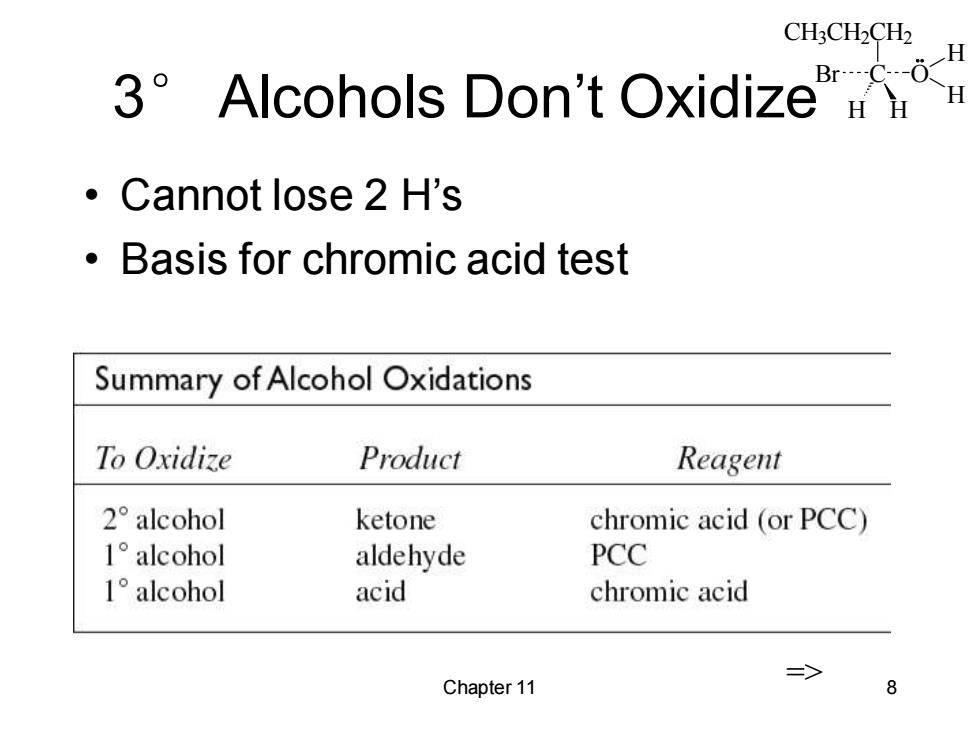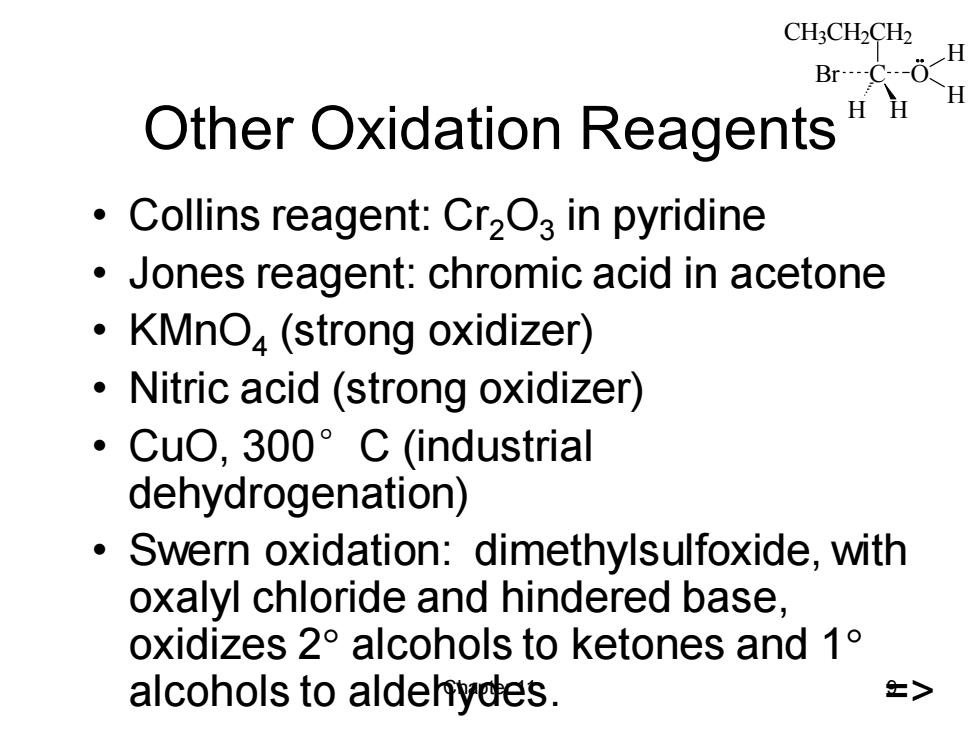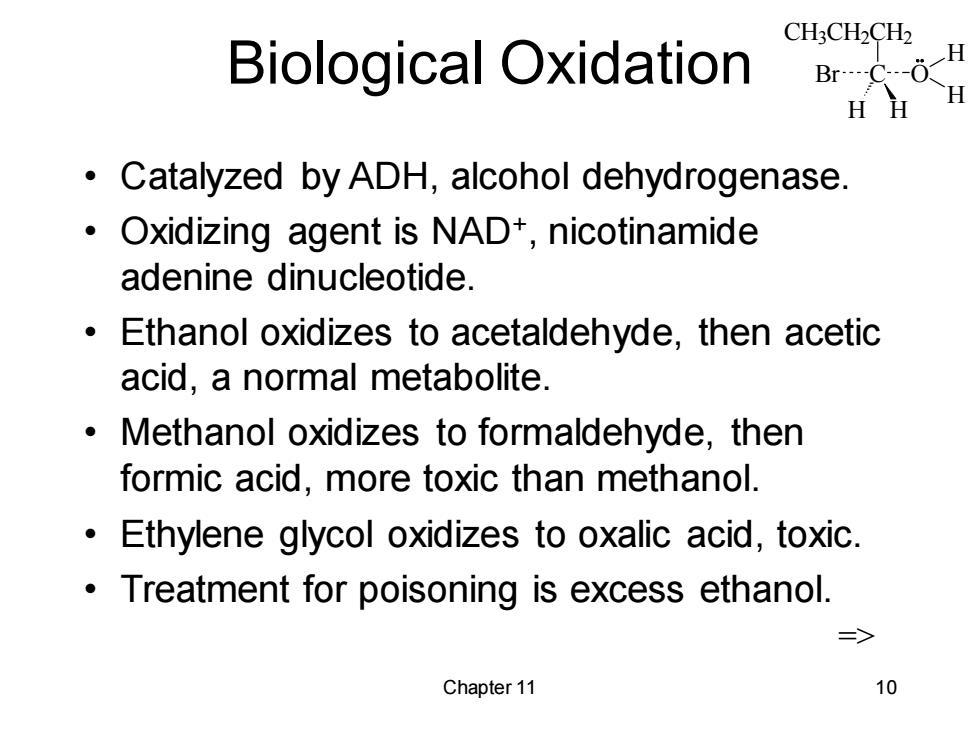
CH3CH2CH2 H Br…C-0 H Oxidation of 2 Alcohols HH ·2°alcohol becomes a ketone Reagent is Na2Cr2O-/H2SO Active reagent probably H2CrO Color change:orange to greenish-blue OH Na2Cr207/H2SO4 CH:CHCH-CH CHCCH2CHs => Chapter 11 6
CH3CH2CH2 C H H Br O H H Chapter 11 6 Oxidation of 2° Alcohols • 2° alcohol becomes a ketone • Reagent is Na2Cr2O7 /H2SO4 • Active reagent probably H2CrO4 • Color change: orange to greenish-blue CH3 CHCH2 CH3 OH Na2 Cr 2 O7 / H2 SO4 CH3 CCH2 CH3 O =>

CH3CH2CH2 H Oxidation of 1 Alcohols" H ·1°alcohol to aldehyde to carboxylic acid Difficult to stop at aldehyde Use pyridinium chlorochromate(PCC) to limit the oxidation. ·PCC can also be used to oxidize2° alcohols to ketenes. OH N-H CrO3CI CH:CH2CH2CH2 CH:CH-CH2CH 二> Chapter 11
CH3CH2CH2 C H H Br O H H Chapter 11 7 Oxidation of 1° Alcohols • 1° alcohol to aldehyde to carboxylic acid • Difficult to stop at aldehyde • Use pyridinium chlorochromate (PCC) to limit the oxidation. • PCC can also be used to oxidize 2° alcohols to ketones. CH3CH2CH2CH2 OH N H CrO3Cl CH3CH2CH2CH O =>

CH3CH2CH2 3 Alcohols Don't Oxidize H 。Cannot lose2H's Basis for chromic acid test Summary of Alcohol Oxidations To Oxidize Product Reagent 2°alcohol ketone chromic acid (or PCC) 1°alcohol aldehyde PCC 1°alcohol acid chromic acid => Chapter 11 8
CH3CH2CH2 C H H Br O H H Chapter 11 8 3° Alcohols Don’t Oxidize • Cannot lose 2 H’s • Basis for chromic acid test =>

CH3CH2CH2 H Other Oxidation Reagents HH Collins reagent:Cr2O in pyridine Jones reagent:chromic acid in acetone ·KMnO4(strong oxidizer) Nitric acid (strong oxidizer) ·CuO,300°C(industrial dehydrogenation) Swern oxidation:dimethylsulfoxide,with oxalyl chloride and hindered base, oxidizes 2 alcohols to ketones and 1 alcohols to aldehydes. E>
CH3CH2CH2 C H H Br O H H Chapter 11 9 Other Oxidation Reagents • Collins reagent: Cr2O3 in pyridine • Jones reagent: chromic acid in acetone • KMnO4 (strong oxidizer) • Nitric acid (strong oxidizer) • CuO, 300°C (industrial dehydrogenation) • Swern oxidation: dimethylsulfoxide, with oxalyl chloride and hindered base, oxidizes 2 alcohols to ketones and 1 alcohols to aldehydes. =>

CH3CH2CH2 Biological Oxidation Br----C--- HH Catalyzed by ADH,alcohol dehydrogenase. Oxidizing agent is NAD+,nicotinamide adenine dinucleotide. Ethanol oxidizes to acetaldehyde,then acetic acid,a normal metabolite. Methanol oxidizes to formaldehyde,then formic acid,more toxic than methanol. Ethylene glycol oxidizes to oxalic acid,toxic. Treatment for poisoning is excess ethanol. => Chapter 11 10
CH3CH2CH2 C H H Br O H H Chapter 11 10 Biological Oxidation • Catalyzed by ADH, alcohol dehydrogenase. • Oxidizing agent is NAD+ , nicotinamide adenine dinucleotide. • Ethanol oxidizes to acetaldehyde, then acetic acid, a normal metabolite. • Methanol oxidizes to formaldehyde, then formic acid, more toxic than methanol. • Ethylene glycol oxidizes to oxalic acid, toxic. • Treatment for poisoning is excess ethanol. =>